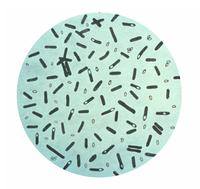
Photo from wikipedia
Microorganisms alter gene and protein expression in response to environmental conditions to adapt and survive. Whereas the genetic composition of a microbe represents an organism’s biological potential, the proteins expressed… Click to show full abstract
Microorganisms alter gene and protein expression in response to environmental conditions to adapt and survive. Whereas the genetic composition of a microbe represents an organism’s biological potential, the proteins expressed provide a functional readout of the organism’s response to the environment. Understanding protein expression patterns in response to specific environmental conditions furthers fundamental knowledge about a microbe, which can be especially useful for understudied organisms such as Clostridium botulinum examined herein. In addition, protein expression patterns that reproducibly occur in certain growth conditions hold potential in fields such as microbial forensics, in which determination of conditions in which an unknown possible biothreat sample had been grown may be important. To investigate the identity and reproducibility of protein profile patterns for varied strains, we defined the proteomic profiles of four Group I strains of Clostridium botulinum, a Category A biothreat agent and the organism responsible for the production of the botulinum neurotoxin (BoNT), in two different culture media grown for five days. The four C. botulinum strains produced one of three neurotoxins (BoNT/A, /B, or /F), and their protein profiles were compared to that of a fifth non-toxigenic strain of C. sporogenes. These strains each had DNA sequences available to assist in accurate protein identification. Differing culture growth phase, bacterial strain, and growth medium resulted in reproducible protein profiles, which were used to calculate relative protein abundance ratios as an internally normalized metric of microbial growth in varying conditions. The resulting protein profiles provide functional information about how four Group I C. botulinum strains and a C. sporogenes strain respond to the culture environment during growth and explores the feasibility of using these proteins to characterize unknown samples.
Journal Title: PLoS ONE
Year Published: 2018
Link to full text (if available)
Share on Social Media: Sign Up to like & get
recommendations!